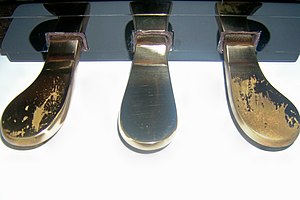Once I used the phrase soft pedal in e-mail to an erudite friend, in a form like this: “I intend to soft pedal my idea so as not to stir up controversy and resistance.” The friend corrected me, claiming that the preferred phrase is soft peddle.
A bit of Google research indicates that although my version is far more common, my friend’s usage is conceivable.
As a pianist I know that the left pedal of three on a piano is most often called the soft pedal. Its function on a grand piano is to move the whole action slightly to the side so that the hammers that normally strike three strings strike only two, and those that strike two only one. On an upright it moves the whole set of hammers closer to the strings. The result is similar, a softening of the sound that is different from merely playing with a lighter touch. The traditional instruction found in music to use the soft pedal is una corda (Italian for one string), and to release it is tre corde (three strings). (In practice, neither is often very encountered.)
Therefore, to metaphorically soft pedal an idea or a request, would be to offer it unassertively.
The verb to peddle means to sell. To soft peddle an idea, an instruction, or a physical object would certainly be understood to mean promoting its acceptance without attempting to hard sell it as by direct confrontation amounting to a commercial, preferring instead to employ suggestion, gentle persuasion, or incidental reference.
Whether soft pedal or soft peddle, although the mental imagery triggered is slightly different, the intended meaning would be close to the same for either one and therefore either expression would work, depending on the intended metaphor.
Related articles
- Do piano pedals change the sound (wiki.answers.com)



